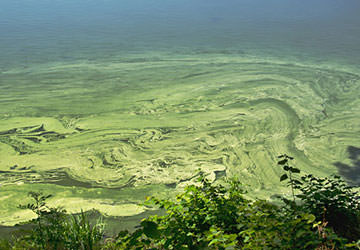Cyanobacteria (Blue-Green Algae)
algae identification
Cyanobacteria, also known as blue-green algae, are a group of photosynthetic bacteria that are found in diverse habitats worldwide. They are some of the oldest known organisms on Earth, with fossil evidence dating back over 3.5 billion years, and they play crucial roles in various ecosystems.
- A bloom will appear green, blue-green or green-brown in colour
- Blooms appear string-like or like a “paint spill” across the water’s surface
- The water may look like “pea soup”
- If you insert a stick into the bloom, the cyanobacteria will disperse and cloud the water, and look like paint on the stick.
- Duckweed (aquatic plant)
- Rootless duckweed is the smallest vascular plant on earth, but can be identified by individual spheres. Unlike cyanobacteria, which cannot be identified by sight as individual cells.
- Common duckweed has a single root hanging in the water and one, two or three leaves.
- Spirogyra (green, string algae)
- Can be identified by stringy, hair like algae that can be picked up and draped over a stick.
- Tree pollen
- Pollen will appear yellow and dusty in texture
Cyanobacteria play essential roles in ecosystems as primary producers and nitrogen fixers. In aquatic environments, they form the base of the food chain, providing food for a variety of organisms, from zooplankton to fish. Additionally, cyanobacteria can fix atmospheric nitrogen into a usable form, enriching soils and supporting plant growth.
What does Cyanobacteria (Blue-Green Algae) look like?
Disadvantages of Cyanobacteria (Blue-Green Algae)
Under certain conditions, cyanobacteria can undergo rapid growth and form dense blooms, known as cyanobacterial blooms or harmful algal blooms (HABs). Some cyanobacteria produce toxins, such as microcystins and cylindrospermopsin, which can pose health risks to humans and animals if ingested or if there is skin contact with contaminated water.
treatment
Coptrol – Algaecide control designed to kill algal cells. Use on mild to severe algae blooms
GreenClear Pond – This treatment is designed for manmade enclosed fish ponds only. GreenClear Pond targets green slime and sludge and is safe for fish.
prevention options
Aquatic Blue Dye – Blue dye that may reduce temperature of the water body by reducing UV light penetration. This may then increase oxygen saturation.
Phoslock – Phosphorous is the main food source for algae. By reducing the nutrient input, algae do not have enough food to replicate.
Barley Straw Bales and Barley Straw Extract – Barley Straw works to suppress the future growth of algae
Waterbac – Beneficial Bacteria helps to reduce excess nutrients in the water body which may lead to an algal bloom







